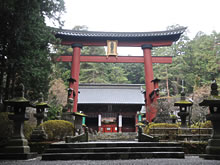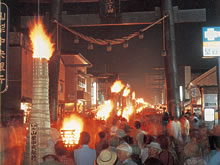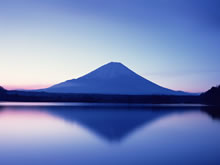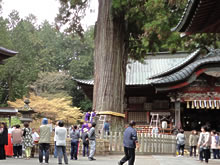

 The shrine is called “Kitaguchi Hongu Fuji Sengen Jinja,” “jinja” being the word for “shrine.” “Sengen,” with the old reading of “asama,” is related to Shinto animistic worship of volcanoes and Sengen branch shrines circle the mountain.
The shrine is called “Kitaguchi Hongu Fuji Sengen Jinja,” “jinja” being the word for “shrine.” “Sengen,” with the old reading of “asama,” is related to Shinto animistic worship of volcanoes and Sengen branch shrines circle the mountain.
The Mt. Fuji has attracted people with its beauty while exposing the threat of eruption since ancient times.
Originally, a person cannot enter the sacred mountain as the God’s place. People hoped that by purifying the body and mind to climb a steep mountain. Then Fuji Pilgrims “Fujikoh” appeared and exploded in the Edo period. Numerous warlords throughout Japan’s history favored this shrine, including Takeda Shingen, one of the most famous military leaders of the Warring States period.
Konohanasakuya-hime-no-mikoto as the main god, which is enshrined the main structure with her husband Ninigi-no-mikoto and her father Ohyamazumi-no-kami. God, wife and husband are to protect the marital harmony and the happiness of the family with her father god.
; The goddess of Mt. Fuji, safe delivery, gave child, Tues-proof and governing the industry. She is ‘incredibly beautiful’ who has been worshiped as a god of beauty, art and entertainment. Previously it had been revered as the god of sake brewing and sericulture.
; A grandson of Amaterasu-ohmikami the most precious god in Japan, a great-grandfather of Jinmu-tennoh the first emperor. The unbroken imperial line is coming from him.
He governed the land of Japan at first from Takamanohara as a higher place, brought 3 major divine decrees us. He is the God from a Takamanohara “higher” place family who also married first a princess of the earth god’s family. So they are the god of connecting and tying.
3 major divine decrees
“Tenjo-mukyu; 天壌無窮” / “Saikyo-kyoudenn; 斎鏡共殿” / “Yuniwa-no-inaho; 斎庭稲穂.”
; The god of all mountains who gave the most splendid mountain to the most beautiful goddess of his daughter.
The myth, he dedicated Ninigi-no-mikoto as the principal god his two daughter. A younger beauty daughter is Konohanasakuya-hime like blooming a flower, another elder “like a rock” daughter is Iwanaga-hime-no-mikoto who protecting a long life. Ninigi-no-mikoto had married with only Konohanasakuya-hime then emperor’s life had been short like a flower.
 The origin is not clear, but people offered thanks for the divine protection of Konohanasakuya-hime-no-mikoto by this festival. It is believed that burning fire. Residents also offer prayers for public welfare and peace. In addition, the fire festival also serves to give thanks for the safety of the current year’s Fuji climb and to close the mountain until the next year.
The origin is not clear, but people offered thanks for the divine protection of Konohanasakuya-hime-no-mikoto by this festival. It is believed that burning fire. Residents also offer prayers for public welfare and peace. In addition, the fire festival also serves to give thanks for the safety of the current year’s Fuji climb and to close the mountain until the next year.
On August 26 and 27, the Yoshida fire festival is held. This festival is designated as one of “the three most unique festivals in Japan.”
Starting from the shrine, bonfires of firewood over 3m tall are set on fire along a 2km stretch of the city’s main street, which becomes a sea of fire. Nevertheless, there has never been fire damage from the bonfires, since Konohanasakuya-hime is known as the goddess of fire safety, easy delivery and good industry. It is said that she gave birth in the midst of a raging fire to prove her fidelity.
The climax of the fire festival is very forceful, truly sublime and fantastic.
 The first gate is “Kanadorii,” near Fujiyoshida station, the second stands at the entrance of the approach to Sengen Jinja, the third is “Otorii.” And this torii gate located at the west side of the shrine complex serves as the entrance to the Yoshidaguchi climbing trail. It is considered the starting point for the Mt.Fuji pilgrimage.
The first gate is “Kanadorii,” near Fujiyoshida station, the second stands at the entrance of the approach to Sengen Jinja, the third is “Otorii.” And this torii gate located at the west side of the shrine complex serves as the entrance to the Yoshidaguchi climbing trail. It is considered the starting point for the Mt.Fuji pilgrimage.
 The complex, still in the midst of a dense, old forest, had long been considered an auspicious location for the spirit, religious world of animism.
The complex, still in the midst of a dense, old forest, had long been considered an auspicious location for the spirit, religious world of animism.
Four trees in a wide square were said to have been selected as the borders of this area. The three trees remaining today are located around the main shrine and these are designated as natural monuments.
Measuring about 23m at their girths, they are about 1000 years old and are believed to protect the shrine.
On both sides of the entrance path are lined many mossy stone lanterns, which was dedicated by believers creating a solemn atmosphere. This precinct covers 99,000㎡ and is one of the largest forest shrines in Japan.